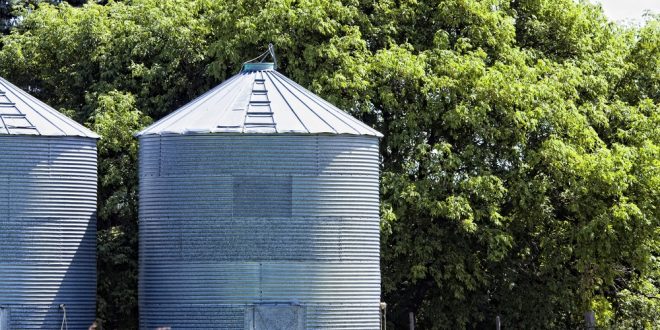By Katie Nichols

Producers are beginning corn harvest after a summer season with sweltering heat and little rainfall. Irrigated corn may have faired well, but producers with dryland corn are hoping for decent yields as they head to the field. The effort and expense in the field may be worth nothing if producers don’t spend time making storage preparations in the grain bin.
Alabama Cooperative Extension System Entomologist, Dr. Kathy Flanders, said the key to storing grains and other commodities on-farm is to make storage conditions unfavorable for the survival of stored-grain insects and molds.
“Preventing insects and molds involves keeping the storage structure and the grain clean and dry, keeping it cool when outside temperatures permit, and applying empty bin and grain protectant insecticides,” Flanders said.
Storage Bin Prep
Clean bins are essential for properly stored grain. Clean the bin inside and out as soon as it is empty to eliminate starter colonies of insects. Remove weeds, crop debris and clutter to reduce insect hiding places.
Flanders said it only takes about one month in warm weather for most stored grain pests to complete a generation.
Seal any gaps or holes in the sides of the bin using caulk or polyurethane foam. Check the bottom seal to be sure it is intact and preventing water flow underneath the bin.
After cleaning and sealing the bin, apply an EPA-approved insecticide on the floors and sides of bins to eliminate hidden insects and to create a first line of defense against any insects that may find come into the bin. Spray a three-foot swath on the outside walls of the bin, and six to 10 feet of the surrounding concrete and sod.
Eventually, insects will build up under the bin floor. Bins with false floors should be fumigated if debris cannot be removed. Click here for more information on EPA-approved insecticides for grain bins or fumigants.
Equipment and Grain Prep
Cleaning harvesting and loading equipment like combines, trucks and augers at the end of each harvest season can prevent insects from reproducing in the small amounts of grain left over in the equipment.
Flanders said storing grain at the appropriate moisture content levels can prevent mold and insect growth.
“The drier the grain, the harder it is for insects and mold to grow. Therefore, recommended moisture content for grain stored for 6 to 12 months is 1 percent less than grain stored for 6 months,” Flanders said. “For example, small grains that will be stored in an aerated bin for 6 months should be placed in the bin at (or dried down to) 12 percent, and small grains to be stored for 6 to 12 months should be placed in the bin at (or dried down to) 13 percent.“
A hand held moisture meter helps check moisture contents in the field prior to harvest.
Storing clean grain without excess fine particles and other foreign debris increases the effectiveness of grain fumigants and protectants. Clean grain storage also helps increase aeration efficiency.
Clean Grain Storage
The following contribute to clean grain without excessive fines or foreign matter:
- Effective in-season weed control
- A properly adjusted combine
- Use of a grain pre-cleaner
- Coring the bin after it is loaded
Applying an approved protectant insecticide as grain is loaded into the bin provides another layer of defense against grain pests.
Flanders said the insecticide could be applied in the loading pit or introduced in the elevator stream at the coolest point after the grain leaves the dryer. She said heat breaks down grain protectants, so it is important not to apply a grain protectant to hot grain.
Once the grain is in the bin, level the surface. Don’t overfill the bin. Leave several feet of the straight side of the bin as air space to facilitate aeration and monitoring. If you plan to store grain for more than a few months, consider applying a top dress treatment.
Additional Storage Preparations
Alabama Extension professionals have written a publication packed with information on cleaning storage bins, protecting stored products, controlling molds and mycotoxins, and temporary storage. The publication also includes lists of approved grain fumigants, top dress treatments and other grain treatments. For more information, contact your local Extension agent or visit Alabama Extension or Alabama Crops online.
Source:aces.edu